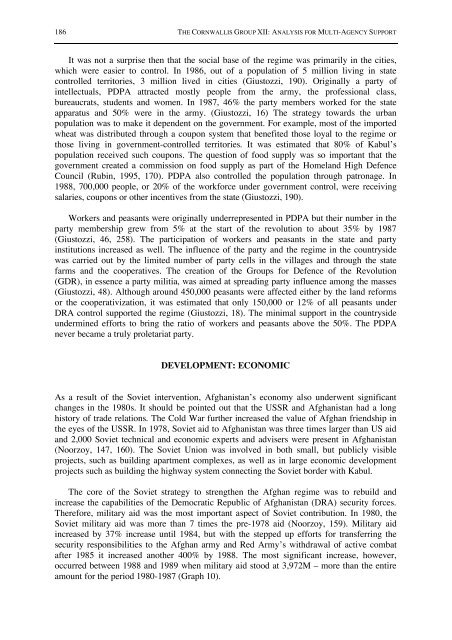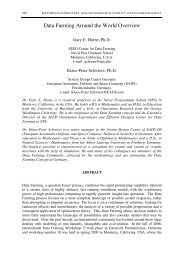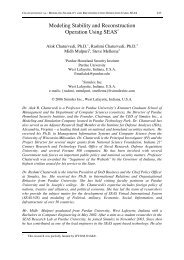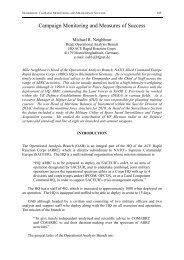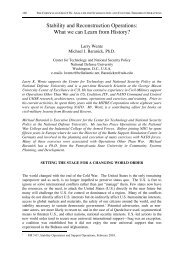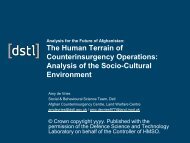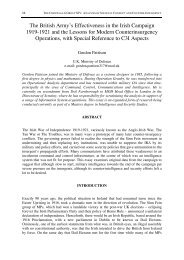Lessons Learned from the Soviet Experience in ... - Cornwallis Group
Lessons Learned from the Soviet Experience in ... - Cornwallis Group
Lessons Learned from the Soviet Experience in ... - Cornwallis Group
Create successful ePaper yourself
Turn your PDF publications into a flip-book with our unique Google optimized e-Paper software.
186 THE CORNWALLIS GROUP XII: ANALYSIS FOR MULTI-AGENCY SUPPORTIt was not a surprise <strong>the</strong>n that <strong>the</strong> social base of <strong>the</strong> regime was primarily <strong>in</strong> <strong>the</strong> cities,which were easier to control. In 1986, out of a population of 5 million liv<strong>in</strong>g <strong>in</strong> statecontrolled territories, 3 million lived <strong>in</strong> cities (Giustozzi, 190). Orig<strong>in</strong>ally a party of<strong>in</strong>tellectuals, PDPA attracted mostly people <strong>from</strong> <strong>the</strong> army, <strong>the</strong> professional class,bureaucrats, students and women. In 1987, 46% <strong>the</strong> party members worked for <strong>the</strong> stateapparatus and 50% were <strong>in</strong> <strong>the</strong> army. (Giustozzi, 16) The strategy towards <strong>the</strong> urbanpopulation was to make it dependent on <strong>the</strong> government. For example, most of <strong>the</strong> importedwheat was distributed through a coupon system that benefited those loyal to <strong>the</strong> regime orthose liv<strong>in</strong>g <strong>in</strong> government-controlled territories. It was estimated that 80% of Kabul’spopulation received such coupons. The question of food supply was so important that <strong>the</strong>government created a commission on food supply as part of <strong>the</strong> Homeland High DefenceCouncil (Rub<strong>in</strong>, 1995, 170). PDPA also controlled <strong>the</strong> population through patronage. In1988, 700,000 people, or 20% of <strong>the</strong> workforce under government control, were receiv<strong>in</strong>gsalaries, coupons or o<strong>the</strong>r <strong>in</strong>centives <strong>from</strong> <strong>the</strong> state (Giustozzi, 190).Workers and peasants were orig<strong>in</strong>ally underrepresented <strong>in</strong> PDPA but <strong>the</strong>ir number <strong>in</strong> <strong>the</strong>party membership grew <strong>from</strong> 5% at <strong>the</strong> start of <strong>the</strong> revolution to about 35% by 1987(Giustozzi, 46, 258). The participation of workers and peasants <strong>in</strong> <strong>the</strong> state and party<strong>in</strong>stitutions <strong>in</strong>creased as well. The <strong>in</strong>fluence of <strong>the</strong> party and <strong>the</strong> regime <strong>in</strong> <strong>the</strong> countrysidewas carried out by <strong>the</strong> limited number of party cells <strong>in</strong> <strong>the</strong> villages and through <strong>the</strong> statefarms and <strong>the</strong> cooperatives. The creation of <strong>the</strong> <strong>Group</strong>s for Defence of <strong>the</strong> Revolution(GDR), <strong>in</strong> essence a party militia, was aimed at spread<strong>in</strong>g party <strong>in</strong>fluence among <strong>the</strong> masses(Giustozzi, 48). Although around 450,000 peasants were affected ei<strong>the</strong>r by <strong>the</strong> land reformsor <strong>the</strong> cooperativization, it was estimated that only 150,000 or 12% of all peasants underDRA control supported <strong>the</strong> regime (Giustozzi, 18). The m<strong>in</strong>imal support <strong>in</strong> <strong>the</strong> countrysideunderm<strong>in</strong>ed efforts to br<strong>in</strong>g <strong>the</strong> ratio of workers and peasants above <strong>the</strong> 50%. The PDPAnever became a truly proletariat party.DEVELOPMENT: ECONOMICAs a result of <strong>the</strong> <strong>Soviet</strong> <strong>in</strong>tervention, Afghanistan’s economy also underwent significantchanges <strong>in</strong> <strong>the</strong> 1980s. It should be po<strong>in</strong>ted out that <strong>the</strong> USSR and Afghanistan had a longhistory of trade relations. The Cold War fur<strong>the</strong>r <strong>in</strong>creased <strong>the</strong> value of Afghan friendship <strong>in</strong><strong>the</strong> eyes of <strong>the</strong> USSR. In 1978, <strong>Soviet</strong> aid to Afghanistan was three times larger than US aidand 2,000 <strong>Soviet</strong> technical and economic experts and advisers were present <strong>in</strong> Afghanistan(Noorzoy, 147, 160). The <strong>Soviet</strong> Union was <strong>in</strong>volved <strong>in</strong> both small, but publicly visibleprojects, such as build<strong>in</strong>g apartment complexes, as well as <strong>in</strong> large economic developmentprojects such as build<strong>in</strong>g <strong>the</strong> highway system connect<strong>in</strong>g <strong>the</strong> <strong>Soviet</strong> border with Kabul.The core of <strong>the</strong> <strong>Soviet</strong> strategy to streng<strong>the</strong>n <strong>the</strong> Afghan regime was to rebuild and<strong>in</strong>crease <strong>the</strong> capabilities of <strong>the</strong> Democratic Republic of Afghanistan (DRA) security forces.Therefore, military aid was <strong>the</strong> most important aspect of <strong>Soviet</strong> contribution. In 1980, <strong>the</strong><strong>Soviet</strong> military aid was more than 7 times <strong>the</strong> pre-1978 aid (Noorzoy, 159). Military aid<strong>in</strong>creased by 37% <strong>in</strong>crease until 1984, but with <strong>the</strong> stepped up efforts for transferr<strong>in</strong>g <strong>the</strong>security responsibilities to <strong>the</strong> Afghan army and Red Army’s withdrawal of active combatafter 1985 it <strong>in</strong>creased ano<strong>the</strong>r 400% by 1988. The most significant <strong>in</strong>crease, however,occurred between 1988 and 1989 when military aid stood at 3,972M – more than <strong>the</strong> entireamount for <strong>the</strong> period 1980-1987 (Graph 10).


